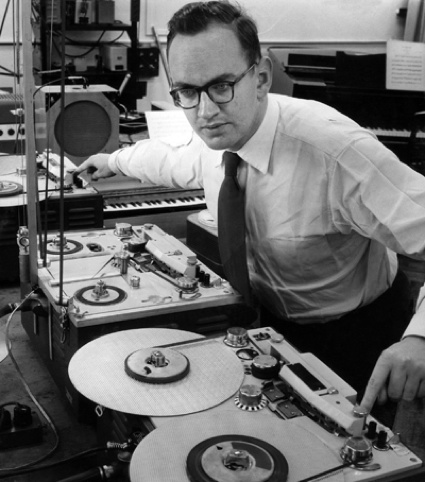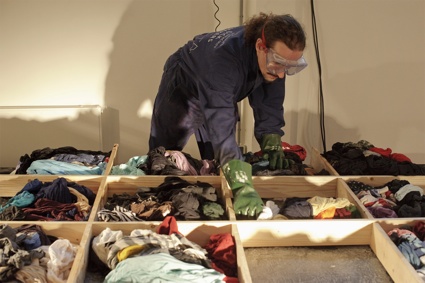 Michiel Pijpe and the Artscience Interfaculty, Volta, Dick Raaijmakers (’95) at the Age of Wonder Festival. Photo by Sas Schilten
Michiel Pijpe and the Artscience Interfaculty, Volta, Dick Raaijmakers (’95) at the Age of Wonder Festival. Photo by Sas Schilten
 Michiel Pijpe and the Artscience Interfaculty, Volta, Dick Raaijmakers (’95) at the Age of Wonder Festival. Photo by Sas Schilten
Michiel Pijpe and the Artscience Interfaculty, Volta, Dick Raaijmakers (’95) at the Age of Wonder Festival. Photo by Sas Schilten
In 1800, Alessandro Volta made the first electro chemical battery. The ‘voltaic pile‘ demonstrated that a moist, porous material sandwiched between two dissimilar metals can produce an electrical current. The scientist tested several metals and found that zinc and silver gave the best results.
In his experiment, Volta used a disk of copper, covered it with a disk of cloth soaked in brine (i.e., the electrolyte), and stacked that with a disk of zinc. He repeated the copper-cloth-zinc disks piling up until the pile reached a height of about 30 cm. The positive end of the pile is the bottom copper disk, and the negative end is the zinc disk on top.
Volta’s experiment was re-enacted on a gigantic scale at the Age of Wonder festival a few weeks ago in Eindhoven. Or maybe i should write that Michiel Pijpe and the Artscience Interfaculty re-enacted the re-enactment of the voltaic pile discovery that media art pioneer Dick Raaijmakers realized in 1995. Raaijmakers (or Raaymakers) is regarded as one of the founders of the Dutch electronic music. He is also closely connected to Eindhoven through his research at the Natlab (Philips Research Laboratories) in the fifties.
 Dick Raaymakers at the Philips NatLab (image via V2_)
Dick Raaymakers at the Philips NatLab (image via V2_)
Over the course of a several hour long performance, the Volta team built up a giant and foul-smelling pile that alternated copper plates, clothes drenched in acid and zinc.
I didn’t stand and stare until the final moments of the performance but I wish i had. The goal was to use the oversized battery to produce enough energy for one light bulb, suspended from the ceiling. I might have missed the grand finale but i’ve nevertheless been impressed by this over-sized lesson in physics and by the calm, repetitive gestures required to light up a mundane bulb for a few seconds. Also, it’s always good to be reminded what a genius Raaijmakers was.
Thus, the audience can experience the relation between the invested labor and the resulting electric energy. And also, how and why the original visual quality of this ‘proto-element’ has been lost in favor of the efficiency of the modern battery. ‘Volta’ intends to recreate this lost plasticity, if only for a single moment.
 Michiel Pijpe and the Artscience Interfaculty, Volta, Dick Raaijmakers (’95) at the Age of Wonder Festival. Photo by Sas Schilten
Michiel Pijpe and the Artscience Interfaculty, Volta, Dick Raaijmakers (’95) at the Age of Wonder Festival. Photo by Sas Schilten
 Michiel Pijpe and the Artscience Interfaculty, Volta, Dick Raaijmakers (’95) at the Age of Wonder Festival. Photo by Sas Schilten
Michiel Pijpe and the Artscience Interfaculty, Volta, Dick Raaijmakers (’95) at the Age of Wonder Festival. Photo by Sas Schilten
 Michiel Pijpe and the Artscience Interfaculty, Volta, Dick Raaijmakers (’95) at the Age of Wonder Festival. Photo by Sas Schilten
Michiel Pijpe and the Artscience Interfaculty, Volta, Dick Raaijmakers (’95) at the Age of Wonder Festival. Photo by Sas Schilten
 Michiel Pijpe and the Artscience Interfaculty, Volta, Dick Raaijmakers (’95) at the Age of Wonder Festival. Photo by Sas Schilten
Michiel Pijpe and the Artscience Interfaculty, Volta, Dick Raaijmakers (’95) at the Age of Wonder Festival. Photo by Sas Schilten
 Michiel Pijpe and the Artscience Interfaculty, Volta, Dick Raaijmakers (’95) at the Age of Wonder Festival. Photo by Sas Schilten
Michiel Pijpe and the Artscience Interfaculty, Volta, Dick Raaijmakers (’95) at the Age of Wonder Festival. Photo by Sas Schilten
 Michiel Pijpe and the Artscience Interfaculty, Volta, Dick Raaijmakers (’95) at the Age of Wonder Festival. Photo by Sas Schilten
Michiel Pijpe and the Artscience Interfaculty, Volta, Dick Raaijmakers (’95) at the Age of Wonder Festival. Photo by Sas Schilten
